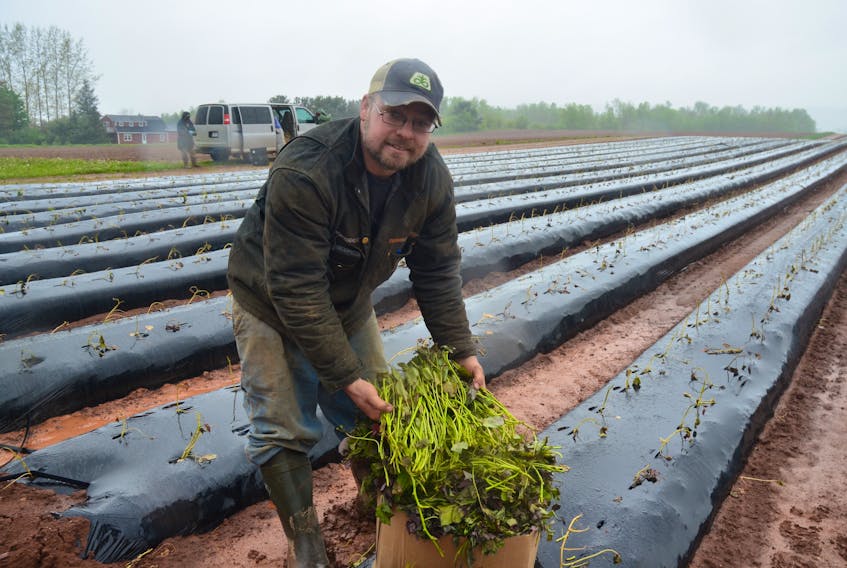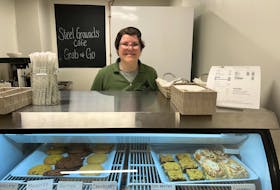LAKEVILLE, N.S. — A newly developed variety is presenting an opportunity for the biggest sweet potato farm east of Ontario to finally tap into the lucrative Thanksgiving market.
Philip and Katie Keddy of Lakeville are among the first farmers in the country trying out a new, Canadian-developed variety of sweet potato called Radiance.
Developed by Ontario’s Vineland Research and Innovation Centre, Radiance has been bred specifically for Canada’s unique weather conditions. Since they are grown in a greenhouse, the sweet potato slips are more expensive than the traditional variety. The slips were due to arrive at the Keddy farm on June 7.
“I have enough seed stock coming from Ontario to put in four acres of the Radiance this year,” Philip said. “It will give me a good idea of the yield potential on it.”
The Keddys have traditionally grown a sweet potato variety from North Carolina called Covington that is better suited to warmer climates and longer growing seasons. They’ll be planting 70 acres or approximately 1.5 million slips of Covington this spring.
Covington requires a 120-day growing season, but Radiance matures two to three weeks earlier. This represents an opportunity to have sweet potatoes available to consumers in time for Thanksgiving, a market the Keddys haven’t been able to take advantage of in the past. For the consumer, Keddy said, Radiance would cost the same as other varieties.
The Keddys have a climate-controlled warehouse that will hold 1.5 million pounds of sweet potatoes. After harvesting, the crop has to be cured, kind of like onions. Using heat, the outer layer of the skin is dried over six or seven days. The sweet potatoes are then cooled and stored for packing.
FAMILY FARM EVOLVES

Keddy said his parents, Charles and Doris, started the farm from scratch more than four decades ago and built it into what it is today, focusing on strawberry plants. They also grow late season strawberries, which they freeze and sell across Canada and the northern United States.
Keddy wanted to introduce something to the farm that he could call his own and that would help grow the business. He saw that opportunity in sweet potatoes.
They have an abundance of labour on hand for the strawberry crops but there are down times. Keddy said the planting and harvesting of sweet potatoes fit perfectly into these windows.
He put in the first test plots after graduating from the Nova Scotia Agricultural College in 2006. The Keddys grew them on a small scale for several years, adapting growing techniques as they learned the nuances of the crop.
“We’ve went to black plastic, which increases our heat, we’ve gone to drip irrigation, we’ve looked at different fertilizers and everything to maximize the size,” Keddy said. “Now, after that many years, we’re finally getting nice, big uniform potatoes that are market size or what the stores want.”
They’ve been selling to Sobeys, the family’s biggest buyer, for about five years now. The Keddys have the largest sweet potato farm east of Ontario. There is a farm in Quebec growing about 40 or 50 acres and a couple of smaller farms in the Valley growing a few acres.
With the consumption of sweet potatoes nearly doubling between 2007 and 2012, Keddy said they’ve really “rode the curve” and he believes the crop is still gaining in popularity.
“It’s a great substitution for white potatoes as far as I’m concerned,” he said.
CHALLENGES AND RISKS
Keddy said they are “pushing the limit with this particular crop in the Valley.” It is a labour intensive crop that is hand-planted and hand-harvested. You need enough labour to get the slips planted quickly or else they’ll start rotting.
The weather is the biggest wild card. Last year, a freeze in early June killed about 20 per cent of the Keddys’ plants. In the fall, you have to get the crop out of the ground before it gets too cold.
The Annapolis Valley features the best growing conditions for sweet potatoes in Atlantic Canada with more heat and frost-free days. Yields drop significantly outside the region.
The Keddys normally would have had the hills pulled a week to 12 days ahead of the planting so the black plastic would have time to heat the soil. This spring, the fields have been too wet to get much of a head start and the ground is cool, so it will likely take the sub-tropical slips longer to root.
They had hoped to begin planting the Radiance slips the week of May 27.

DID YOU KNOW?
The Keddy family has been cast in a web documentary series called Real Farm Lives. The show offers an unfiltered glimpse into the daily lives of Canadian farmers.
In July, they will be shooting episodes for the second season. The episodes will be shown beginning in the fall of 2019.
Philip and Katie have two sons, Charlie and Ben, ages six and four. Keddy said they are developing an interest in agriculture and could represent the third generation for the farm.
RELATED:









